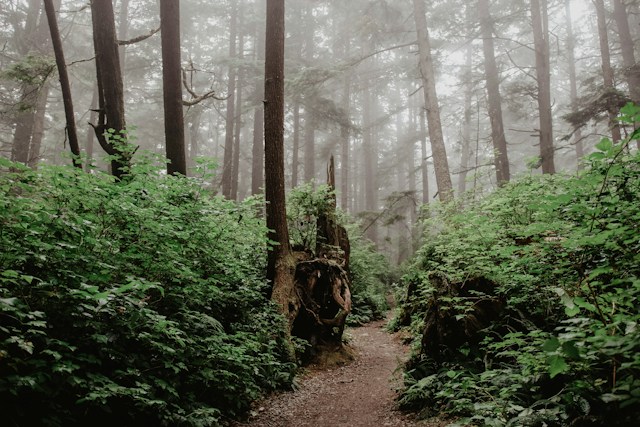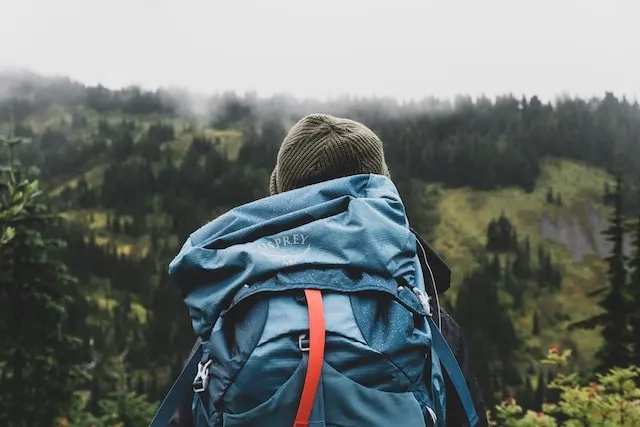Solo backpacking, once considered an unconventional choice, is gaining popularity among adventurers. It allows adventurers to seek a unique and personal experience.

In this article, we’ll explore the world of backpacking:
- Backpacking alone
- Discussing the benefits
- Challenges
- Safety measures
- Inspiring stories that make solo backpacking a transformative journey.
Introduction
Definition of Backpacking Alone
Solo backpacking involves exploring the great outdoors without the company of others. It’s a journey where the backpacker relies solely on their skills, decisions, and resourcefulness.
Growing Trend in Solo Backpacking
In recent years, the trend of backpacking alone has seen a significant rise, challenging the traditional notion that adventure is best shared.
Benefits of Backpacking Alone
Personal Growth and Independence
Solo backpacking is a great way to challenge yourself and grow as a person. It forces you to rely on yourself and step out of your comfort zone, which can lead to a greater sense of independence and self-confidence.
It’s an opportunity to learn how to navigate unfamiliar situations and problem-solve on your own. It ultimately leads to personal growth and a deeper understanding of yourself.
Flexibility and Freedom
Traveling alone can provide a lot of flexibility for backpackers. It allows them to change their plans on a whim and explore off-the-beaten-path destinations without having to consult with anyone else.
This can lead to some truly unique and memorable experiences that may not be possible when traveling with others.
Solo travel can also provide a sense of independence and self-reliance, as well as the opportunity to meet new people and immerse oneself in different cultures.
It can be a very rewarding and enriching experience for those who are willing to embrace the freedom and adventure that comes with traveling alone.
Deep Connection with Nature
Being alone in the wilderness can provide a unique opportunity to connect with nature on a deeper level. It allows for a sense of tranquility and solitude that can foster a profound appreciation for the natural world.
This experience can help individuals develop a greater understanding and respect for the environment, as well as a sense of peace and calm.
Challenges Faced by Solo Backpackers
Safety Concerns
Solo backpackers must prioritize safety above all else when embarking on their adventures. This involves careful planning, thorough risk assessment, and preparation for any potential emergencies.

It’s important to research the area you’ll be traveling to, including potential hazards and safety concerns. Additionally, packing essential safety items such as a first aid kit, emergency communication devices, and navigation tools is crucial.
It’s also wise to leave a detailed itinerary with someone you trust and to regularly check in with them. Being vigilant and prepared can help ensure a safe and enjoyable backpacking experience.
Loneliness on the Trail
The solitude of solo backpacking can lead to loneliness, impacting the overall experience. Strategies to combat this will be explored later in the article.
Solo backpacking can be a rewarding experience, but it can also lead to feelings of loneliness. In this article, we will explore strategies to combat this and enhance the overall experience of solo backpacking.
Decision-Making Pressure
Backpacking alone can add a level of pressure and responsibility, as you have to make all decisions independently. It’s important to carefully plan and prepare for your trip and be confident in your ability to handle any challenges that may arise.
It can be a rewarding and liberating experience, but it’s not for everyone. It’s important to consider your comfort level and experience before embarking on a solo backpacking trip.
Essential Tips for Safe Solo Backpacking
Thorough Planning and Research
It is essential to conduct extensive research on your chosen destination before embarking on a solo backpacking trip.
This includes understanding the weather conditions you may encounter and potential hazards such as wildlife, natural disasters, or political instability.
By thoroughly preparing and staying informed, you can help ensure a safe and enjoyable experience.
Proper Gear and Equipment
It’s crucial to have the right gear for any outdoor adventure. A reliable backpack will help you carry all your essentials comfortably and securely. Proper clothing for the weather and terrain will keep you safe and comfortable throughout your journey.

Navigation tools, such as maps and GPS devices, are essential for staying on course and finding your way in unfamiliar areas. Overall, having the right gear can make a significant difference in ensuring a safe and enjoyable outdoor experience.
Communication Strategies
Communicating regularly with friends or family while backpacking solo is essential for safety. Establishing check-in plans can provide peace of mind for both the backpacker and their loved ones.
This could involve setting specific times for regular updates or sharing location information through GPS tracking.
Having a communication plan in place ensures that someone is aware of the backpacker’s whereabouts and can provide assistance if needed.
Overcoming Loneliness on the Trail
Embracing Solitude
Learning to appreciate solitude as a source of introspection and self-discovery can be incredibly beneficial in overcoming feelings of loneliness.
When we embrace time alone, we have the opportunity to truly understand ourselves, our thoughts, and our emotions. This can lead to a deeper sense of self-awareness and a greater understanding of our own needs and desires.
Solitude allows us to reflect on our experiences and gain valuable insights that can lead to personal growth and development.
By learning to appreciate solitude, we can cultivate a sense of inner peace and find fulfillment within ourselves, ultimately reducing feelings of loneliness.
Connecting with Other Backpackers
Connecting with fellow backpackers on the trail can be a great way to alleviate any feelings of isolation while hiking.
Whether it’s striking up a conversation at a scenic overlook or sharing a meal at a campsite, these interactions provide an opportunity to connect with like-minded individuals and share experiences.

Embracing these opportunities can enhance your overall hiking experience and create lasting memories with new friends.
Utilizing Technology
When hiking, there are ample opportunities to connect with fellow backpackers on the trail. Embracing these interactions can help alleviate any feelings of isolation you may have while out in nature.
Engaging with others can lead to meaningful connections and shared experiences, enhancing your overall backpacking journey. So don’t be afraid to strike up a conversation and make new connections on the trail!
Inspiring Solo Backpacking Stories
A. Personal Narratives
Solo backpacking journeys can be truly transformative experiences for those who take them on.
Many solo travelers have reported feeling a sense of empowerment, increased self-confidence, and a deeper connection to themselves and the world around them.

Hearing about these experiences can be inspiring for anyone considering embarking on a solo backpacking journey themselves.
It can provide valuable insight and motivation for those who are looking to step out of their comfort zone and explore the world on their terms.
B. Lessons Learned from Solo Adventures
Absolutely, seasoned solo backpackers have a wealth of knowledge and experience that can be incredibly valuable for those considering a solo trip.
Their lessons learned can provide insights and tips on everything from packing essentials to navigating unfamiliar terrain.
By tapping into their expertise, aspiring solo travelers can better prepare for their adventures and make the most of their experiences.
Impact on Mental Health
Solitude as a Source of Reflection
Absolutely! Seasoned solo backpackers have a wealth of knowledge and experience to share. They have learned valuable lessons about safety, budgeting, packing efficiently, and navigating different cultures.
Their insights and tips can be incredibly helpful for anyone considering a solo trip, whether it’s their first time or they’re looking to improve their skills. It’s always a great idea to learn from those who have been there and done that!
Boosting Confidence and Self-Esteem
When you face and overcome challenges on your own, you prove to yourself that you are capable and resilient. This can greatly boost your confidence and self-esteem.
It shows that you have the skills and determination to overcome obstacles, which can give you a sense of pride and accomplishment.
Additionally, the more you push yourself out of your comfort zone and achieve success, the more you will believe in your abilities and develop a positive self-image.
Best Solo Backpacking Destinations
Scenic Trails and Remote Locations
Embark on an unforgettable adventure to some of the most stunning and remote locations for solo backpacking. Explore scenic trails that wind through majestic mountains, lush forests, and serene lakeshores.
Experience the tranquility and solitude of remote and untouched landscapes, where you can truly connect with nature and find inner peace.
Whether you seek a challenging trek or a peaceful retreat, these destinations offer a unique and rewarding experience for solo backpackers.
So, pack your gear, lace up your boots, and set out to discover the beauty and serenity of these scenic trails and remote locations.
Cultural and Historical Exploration
Solo backpacking is a wonderful opportunity to immerse oneself in new cultures and histories. It allows for a more intimate and personal experience, giving you a deeper understanding of the world around you.
It can be a transformative and eye-opening experience, providing a unique perspective that may not be possible when traveling with others.
Whether it’s exploring ancient ruins, tasting local cuisine, or meeting new people, solo backpacking offers a rich and fulfilling travel experience.
Common Misconceptions about Solo Backpacking
Addressing Safety Concerns
Solo backpacking is a truly enriching experience that allows you to immerse yourself in different cultures and histories on a personal level.
It provides an opportunity to gain a deeper understanding of the world and connect with people from diverse backgrounds. Through solo backpacking, you can explore new places at your own pace and create meaningful, authentic experiences that will stay with you for a lifetime.
Dispelling Myths about Loneliness
It’s important to dispel the myths about loneliness and solo travel. While some may believe that traveling alone will only lead to feelings of isolation, the reality is quite the opposite.
Solo travel can provide ample opportunities for meaningful connections with others. Whether it’s meeting fellow travelers or engaging with locals, the potential for forming new and enriching relationships is vast.
So, don’t let misconceptions about loneliness hold you back from experiencing the world on your own terms.
Environmental Responsibility
Leave No Trace Principles
Leave No Trace principles are a set of guidelines designed to help outdoor enthusiasts minimize their impact on the environment while enjoying nature.
These principles include things like packing out all trash, staying on designated trails, and respecting wildlife.

By following these principles, solo backpackers can help preserve the natural beauty of the areas they visit and ensure that future generations can also enjoy these outdoor spaces.
Eco-Friendly Backpacking Practices
The Leave No Trace principles are guidelines for outdoor enthusiasts to minimize their impact on the environment while enjoying the outdoors.
These principles include packing out all trash, minimizing campfire impact, respecting wildlife, and staying on designated trails.
By following these principles, solo backpackers can help preserve the natural beauty of the wilderness and protect delicate ecosystems for future generations to enjoy.
Planning a Solo Backpacking Trip
Step-by-Step Guide
Choose a destination – Research different destinations that are suitable for solo backpacking, taking into consideration factors such as safety, difficulty level, and your personal preferences.
Plan your route – Once you have chosen a destination, plan your route and determine the attractions or landmarks you want to visit along the way.
Check the weather – Keep an eye on the weather forecast for your chosen destination to ensure you pack appropriate clothing and gear.
Pack the essentials – Pack essentials such as a tent, sleeping bag, cooking supplies, food, water, first aid kit, navigation tools, and appropriate clothing for the weather conditions
Budgeting and Resources
- When budgeting for a solo backpacking adventure, it’s important to prioritize your expenses and make the most of your available resources. Here are some tips to help you budget effectively:
- Plan your route and accommodations to avoid last-minute expenses.
- Pack light and bring only the essentials to save on baggage fees and transportation costs.
- Consider staying in hostels, camping, or using budget accommodation options to save on lodging expenses.
- Research local food markets and eateries to save on dining costs and experience local cuisine.
- Take advantage of public transportation, walking, or biking to minimize transportation expenses.
- Look for free or low-cost activities and attractions at your destination to make the most of your budget.
Preparing for the Unpredictable
Weather Challenges
Understanding and preparing for unpredictable weather conditions to ensure a safe and enjoyable journey.
It’s important to stay informed about the weather and be prepared for any challenges that may arise during your journey. This can include packing extra layers, checking road conditions, and having a backup plan in case of severe weather.
By staying proactive and adaptable, you can help ensure a safe and enjoyable experience despite unpredictable weather conditions.
Emergency Preparedness
Emergency preparedness for solo backpackers is essential for ensuring their safety while out in the wilderness. It involves having the necessary knowledge and tools to handle unexpected emergencies such as injuries, getting lost, or encountering wildlife.
This includes carrying a first aid kit, navigation tools, emergency shelter, and knowing basic survival skills. Solo backpackers need to plan, be aware of their surroundings, and have a communication plan in case of an emergency.
Being well-prepared can make all the difference in a potentially dangerous situation.
Capturing Memories: Photography Tips
Preserving Moments Solo
As a solo backpacker, capturing the essence of your journey through photography can be a wonderful way to preserve the memories of your travels for a lifetime. Here are some techniques and tips to help you make the most of your photography during your solo adventures:
Plan: Before you embark on your journey, research the destinations you’ll be visiting and make a list of the key sights and experiences you want to capture through your photographs. This will help you stay focused and make the most of your time.
Pack light: As a solo backpacker, you’ll want to keep your gear to a minimum. Invest in a lightweight, versatile camera that will allow you to capture high-quality images without weighing you down.
Embrace natural light: When taking photos outdoors, natural light can be your best friend. Try to shoot during the “golden hour” (just after sunrise or before sunset) for the most flattering light.
Tell a story: Instead of just taking random snapshots,
Sharing Experiences Through Visuals
Visual storytelling is a powerful way for solo backpackers to share their adventures with the world. Through captivating visuals such as photographs and videos, backpackers can convey the beauty, excitement, and challenges of their journeys.
By showcasing stunning landscapes, unique cultures, and personal experiences, they can offer viewers a window into their world and inspire others to explore and appreciate the beauty of our planet.
Whether through social media platforms, personal blogs, or photography exhibitions, solo backpackers have the opportunity to connect with a global audience and make a lasting impact through the power of visual storytelling.
Finding Community in Solo Backpacking
Online Forums and Groups
There are many virtual communities available where solo backpackers can connect with others who share their passion for travel. These communities provide a platform for sharing experiences, seeking advice, and finding like-minded individuals to connect with.
Some popular virtual communities for solo backpackers include online forums, social media groups, and travel websites. These platforms offer a wealth of information and support for solo travelers, making it easier to connect with others and enhance the backpacking experience.
Networking on the Trail
Building connections with fellow backpackers while on the trail can greatly enhance your experience and create a sense of camaraderie and shared experiences. One way to do this is by being open and approachable.
Take the initiative to start conversations with other hikers and be willing to share your own experiences and stories. This can help break the ice and create a bond based on mutual interests and experiences.
Additionally, offering to help others with tasks such as setting up camp or cooking meals can also foster a sense of teamwork and connection.
Lastly, being respectful and considerate of others’ needs and preferences can go a long way in building positive relationships with fellow backpackers.
Conclusion
In conclusion, backpacking alone is not just a journey into the wilderness but also a journey within oneself. The benefits of personal growth, freedom, and a deep connection with nature outweigh the challenges faced by solo backpackers. By addressing safety concerns, embracing solitude, and utilizing modern technology, solo backpackers can embark on transformative adventures.
As you consider your solo backpacking journey, remember the inspiring stories, lessons learned, and the positive impact on mental health. The world is filled with breathtaking destinations waiting to be explored, and solo backpacking might just be the key to unlocking a world of self-discovery and adventure.
- You must read Different Types of Grips in Rock Climbing: Mastering the Art
- Solo Backpacking Challenges and Triumphs
- How to Keep a Tent Dry During Rain? A Camper’s Guide
What is solo backpacking?
Solo backpacking involves exploring the great outdoors without the company of others, relying solely on one’s skills, decisions, and resourcefulness.
Why has solo backpacking become more popular in recent years?
Solo backpacking has gained popularity due to its potential for personal growth, independence, flexibility, and the deep connection with nature it offers.
What are the key benefits of solo backpacking?
Solo backpacking provides opportunities for personal growth, independence, flexibility in travel plans, a deep connection with nature, and a chance to overcome challenges.
How can solo backpackers address safety concerns?
Solo backpackers can prioritize safety through thorough planning, risk assessment, research on destination hazards, packing essential safety items, leaving a detailed itinerary, and regular check-ins with a trusted contact.
How can solo backpackers combat loneliness on the trail?
Solitude can be embraced as a source of introspection, and connecting with other backpackers on the trail, utilizing technology for communication, and engaging in meaningful interactions help combat loneliness.



Pingback: 25 Solo Travel Safety Tips for Adventurous Journeys -